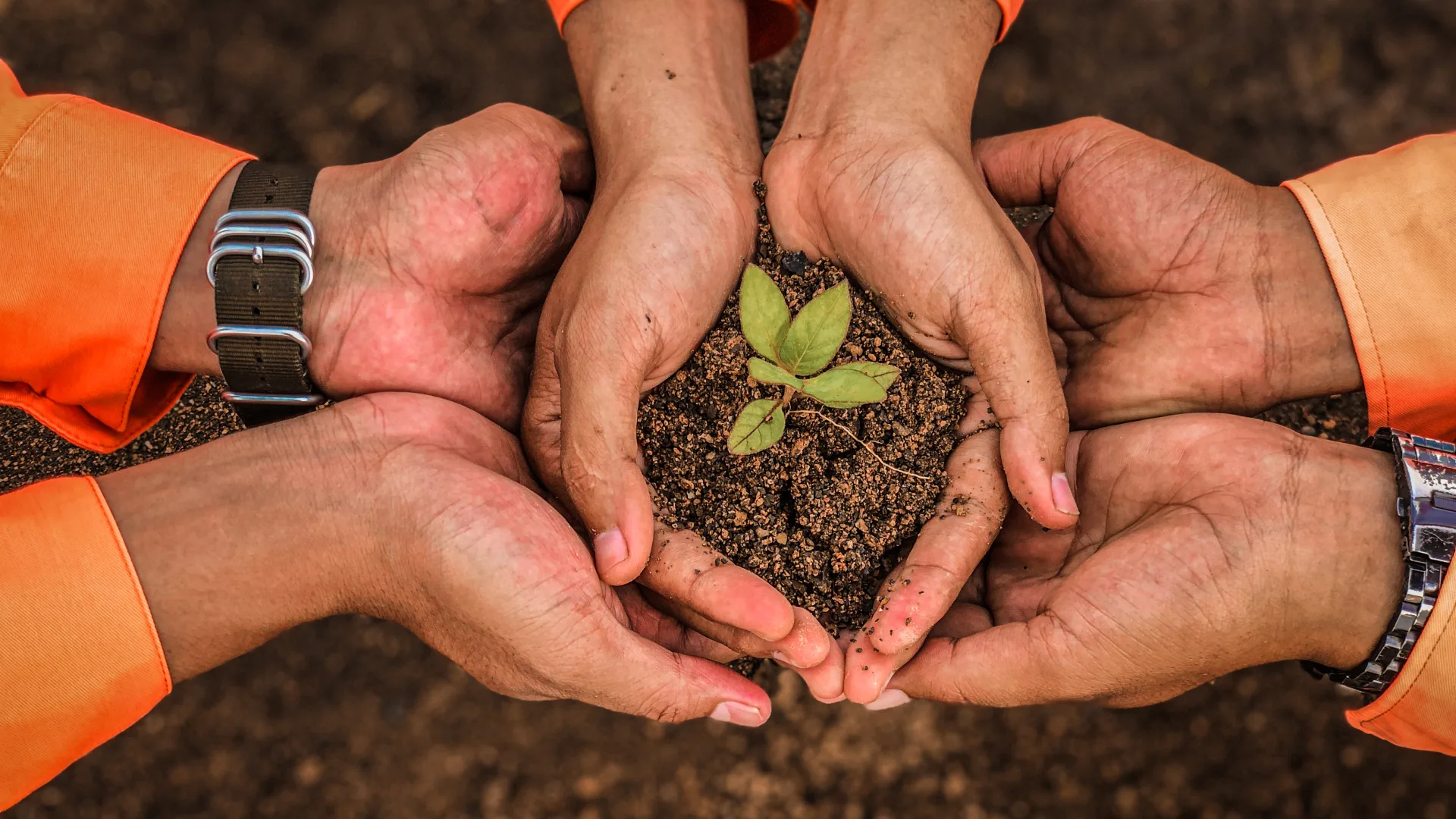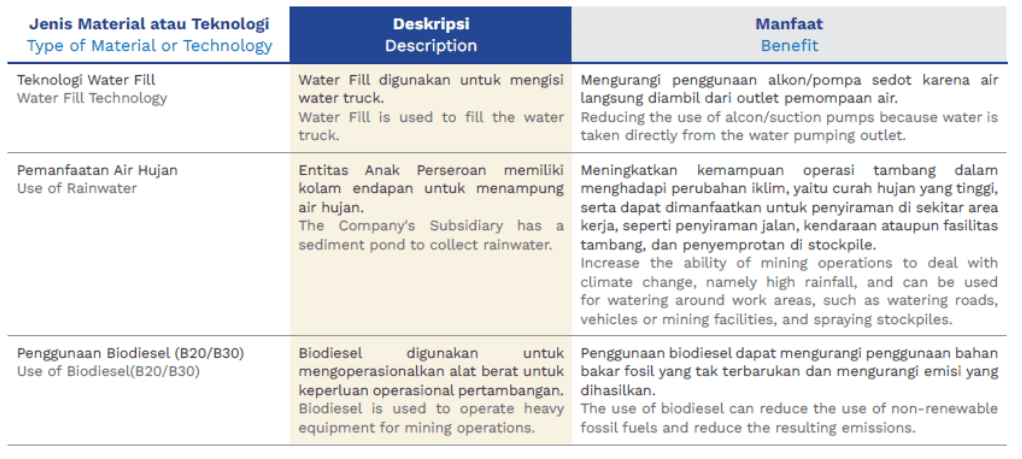We realize that the business activities carried out by the Company contribute to changes in the landscape, namely through land clearing and stripping of overburden, which pose various risks to the environment and society, especially around mining operational areas. Changes in the landscape can cause disruption to the ecological balance, local climate change, and changes in biodiversity. Therefore, we are committed to always implementing environmentally friendly and responsible mining activities carried out in accordance with the Company’s Occupational Health and Safety Policy and environmental permits that apply to the Company, such as AMDAL, Environmental Management Plan (RKL), Environmental Management Plan Environmental Monitoring (RPL), hazardous and toxic waste (B3) permits, wastewater disposal permits, and other environmental documents that have been approved by the local government.
To support the implementation of good mining practices, we have made several efforts, namely:
- Fulfilling licensing requirements according to government and company regulations and prepare periodic reports according to regulations;
- Improving the competence of employees and stakeholders in environmental management and active participation of employees in environmental maintenance programs;
- Carrying out routine maintenance and necessary repairs to environmental management facilities or infrastructure;
- Carrying out land clearing responsibly; as well as
- Maintaining the sustainability of areas that are not used for operational purposes by utilizing them for green open spaces.

Even though there is no conservation area around the mining area, we are still serious about implementing environmental management in order to maintain the sustainability of terrestrial ecosystems, as well as the existing flora and fauna. One of the results of our serious efforts to implement responsible mining practices was realized by receiving a GREEN PROPER certificate in environmental management at the provincial level from the Governor of East Kalimantan and a BLUE PROPER certificate at the national level from the Ministry of Environment and Forestry of the Republic of Indonesia. The company’s performance rating assessment was received by the Company through PT IPC.
The consequence of using energy for operational needs is the production of emissions that contribute to global warming and extreme climate change. Most of the emissions at the site come from mining equipment that still uses fuel.
We have made several efforts to reduce our emissions, including:
• Providing a green area (buffer zone);
• Using environmentally friendly fuel;
• Using a stage wise grinding system in a closed circuit to avoid the formation of fine materials due to over crushing;
• Improving coal mining patterns;
• Carrying out routine watering according to weather conditions at the location of mine roads and production haul roads, excavation operation areas, and coal stockpile areas using a fleet of colt diesel water tanks;
• Installing dust catchers and planting plants around the mine and on the sides of the haul roads;
• Carrying out routine maintenance of transport vehicle engines; as well as
• Modifying the exhaust system of the generator so that it is not excessive by designing exhaust gas emission disposal pipes according to regulations, at least 1.5 times the height of the tallest building at the work site, to prevent inhalation of exhaust gases which can cause health problems.
We always monitor the levels of emissions released into the air as a result of mining activities which can have a negative impact if the levels exceed the set limits. Measurements are carried out routinely every semester in collaboration with the local Center for Environmental and Natural Resources Research.
Water is a resource whose availability in nature is still quite abundant. However, we keep trying to make its use efficient for the sake of environmental sustainability in the future. We have carried out various campaigns to increase the awareness of the Company’s people to use water responsibly.
We manage rainwater that is collected in sediment ponds located around the mining operational area. Rainwater collection is intended for watering roads, vehicles or mine facilities, as well as spraying stockpiles.
Energy is an essential requirement in the Company’s operational activities. We use energy sources that come from electricity, fuel and biodiesel. We always strive for efficient use of energy through the following initiatives:
- Using biodiesel as an environmentally friendly fuel;
- Building hauling infrastructure that shortens coal shipments and reduces fuel use;
- Using air conditioning (AC) with a maximum temperature setting of 240C to save electricity usage in the office area;
- Using electronic equipment with low electric power, one of which is the use of LED lights;
- Turning off all electronic devices, lights or air conditioners when there is no work activity in the room or office area.
We continue to manage noise levels so that operational activities do not interfere with employee productivity and cause social conflicts with other stakeholders that can disrupt the Company’s business continuity. Several efforts have been made to manage noise levels, namely:
• Building employee residences far from the mining and workshop areas
• Providing soundproof buildings where generators are located; as well as
• Providing PPE in the form of ear muffs for workers.
One of the impacts arising from mining activities is an increase in the rate of erosion. To prevent the erosion rate from increasing, we have made several efforts, including:
• Monitor the stability of the slopes so that they comply with safe dimensions based on the principles of good mining techniques;
• Create a drainage system with a slope of 0-2%;
• Creating and maintaining top soil bank areas; as well as
• Planting plants in top soil bank areas with cover crops and woody plants that have strong roots.
We measure soil quality using measuring devices in collaboration with the local Center for Environmental and Natural Resources Research.
The waste generated from the Company’s operational activities can be divided into hazardous and toxic waste, non-hazardous waste, and liquid waste. Management can be carried out internally or through cooperation with licensed third parties.
To ensure that the liquid waste content that will be released does not have a negative impact, we monitor the quality of water in the mine, the rivers around the mine, and residents’ wells. This monitoring is intended to ensure that the condition of wastewater that will be distributed to public irrigation does not exceed predetermined environmental quality standards. Pit water quality monitoring procedures are as follows.
• Monitoring pit water quality on a daily basis at set-up points to check the acidity (pH) level of pit water.
• Monitoring the quality of pit water on a monthly basis by taking water samples at the arrangement point for further testing in a laboratory accredited by the National Accreditation Committee (KAN). In this case, the Company cooperates with the local Provincial Public Service Agency UPTD Health Laboratory and third-party consultants.
• Reporting quarterly test results through environmental reports to the local government, namely the Department of Environment and Land Affairs, the Office of Health, the Office of Manpower, the Office of Energy and Mineral Resources, and the UPTD of Energy and Mineral Resources.
• Reporting test results quarterly online via the SIMPEL website.
This monitoring is intended to determine the condition of the quality of river water before and after being flowed by pit water. Routine river water quality monitoring is carried out every 3 months or quarterly in collaboration with the Center for Industrial Research and Standardization (Baristrand) and the local Provincial Health Laboratory UPTD. River water samples were taken to be tested in laboratories that have been accredited by KAN, according to the test parameters determined by local regulations.
This monitoring is carried out to determine the effect of mining activities on the quality of residents’ well water. Monitoring is carried out periodically every 3 months or quarterly by taking samples at several community well points adjacent to the mine site for further laboratory testing that has been accredited by KAN.
Reclamation activities are carried out by the Company not only to fulfill obligations but also to reduce erosion and restore ecosystems. The implementation of this activity is spread over certain areas, such as in the workshop area, hostel and office complex, ex-mining land, along mining roads, and areas around watersheds using seeds taken from nurseries carried out in nurseries. The types of plants we choose to plant are local endemic plants, such as sengon (Albizia chinensis), trembesi (Samanea saman), durian (Durio zibethinus), meranti (Shorea sp), and acacia (Acacia auriculiformis). In addition, we also store topsoil in a soil bank which will be used as a reclamation medium, if needed.
Parties who have complaints related to environmental problems arising from the Company’s operational activities can report their complaints to the responsible party in the mining operational area or to the head office. As for 2022, the Company will not receive reports of complaints related to environmental problems.


